#alice in wonderland theme
Explore tagged Tumblr posts
Text

Drawn Hacker uwu
21 notes
·
View notes
Text

"Magic Show" —⋆。˚✮⋆˙ ☁︎ ⋆。˚ ⋆。˚✮⋆˙ ☾ ⋆。˚ ⋆。˚✮⋆˙ ☁︎ ⋆。˚ ⋆。˚✮⋆˙—
Weather had Oswald show her the low level spells he knew for the rest of the afternoon, not like he wanted to argue with her.
—⋆。˚✮⋆˙ ☁︎ ⋆。˚ ⋆。˚✮⋆˙ ☾ ⋆。˚ ⋆。˚✮⋆˙ ☁︎ ⋆。˚ ⋆。˚✮⋆˙— { Weather belongs to a friend | Oswald belongs to me } [ Speedpaint ] ⋆ ˚。⋆ ˖⁺‧₊˚。⋆ ˖⁺‧₊˚°˖✧˚ʚ{ MAIN MAP }ɞ˚✧˖° ˚₊‧⁺˖ ⋆˚₊‧⁺˖ ⋆ ˚。⋆
#ghostswow#art#digital art#original art#original character#procreate#oc art#friends ocs#alice in wonderland theme#magic#comic art#comic#short comic
2 notes
·
View notes
Text

Had an ironic dream about Alice in Wonderland, thought I should draw it
#digital artist#art#artist#support human artists#my art#artists on tumblr#procreate art#procreate#alice in wonderland theme#oc art#i crave violence
6 notes
·
View notes
Text


White knight + Red knight
#twst#twisted wonderland#silver vanrouge#silver twst#sebek zigvolt#dark fantasy#knights#armor#inspired by alice through the looking glasss#silver has unicorn sword and sebek horse halberd ehehe#and theyre chess themed#silsebe
1K notes
·
View notes
Text
Fall out boy based on so much for (tour) dust and the msg performance for an illustration assignment:3
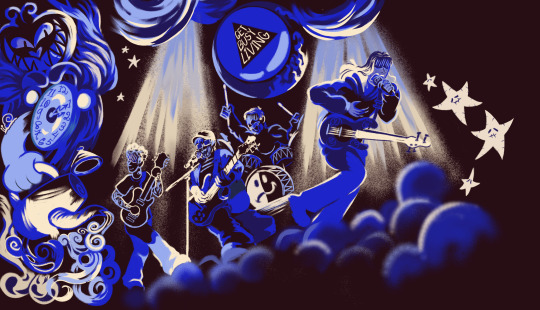
⭐ 🫧 🎱
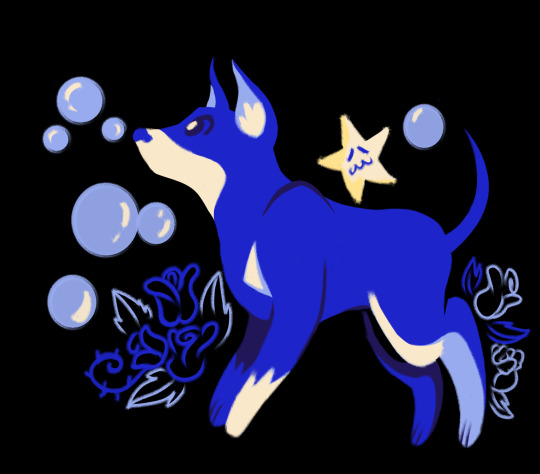
Can you believe Blitz BARELY made it to the cut!? I’m so glad he made it !! (Sorry he looks weird Dobermans aren’t my specialty) + close ups!

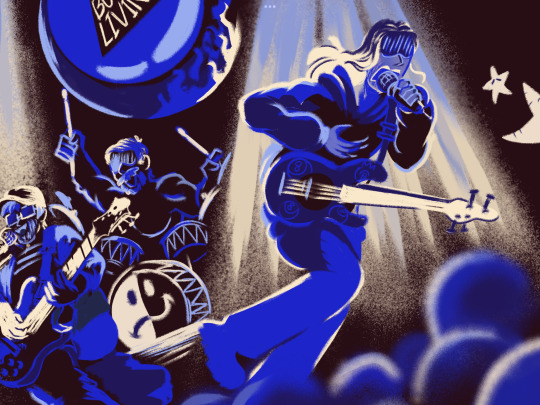
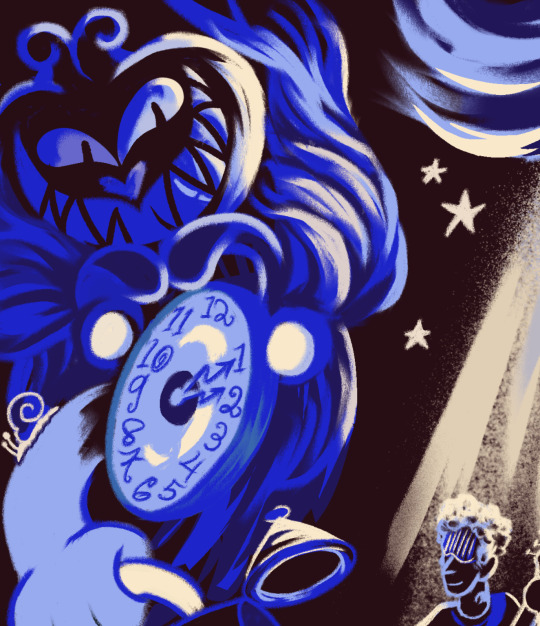
#fall out boy#hackus art#fob#fall out boy fan art#fob fanart#smfs#smfs era#so much for stardust#so much for (tour) dust#blue#yellow#illustration#patrick stump#pete wentz#joe trohman#andy hurley#after finding out the stage was ALICE IN WONDERLAND THEME#I WENT PANIC MODE AND ALTERED 50% OF THE SKETCH💀A FEW DAYS BEFORE THE DEADLINE
579 notes
·
View notes
Text



ᛝᛝ 𝔇𝗋𝗂𝗇𝗄 ℳ𝖾 ─── ㅤ ◞
𓊆 🍽 𓊇 𝖢𝗎𝗋𝗂𝗈𝗎𝗌𝖾𝗋 ﹠̲ 𝖢𝗎𝗋𝗂𝗈𝗎𝗌𝖾𝗋 ┈⵿۪۫۫۫ ⡳









⡳ཻུ۪۪ 𖡄̽ 🐦⬛ 𝖶𝗁𝗒 𝗂𝗌 𝖺 𝗋𝖺𝗏𝖾𝗇 𝗅𝗂𝗄𝖾 𝖺 𝗐𝗋𝗂𝗍𝗂𝗇𝗀 𝖽𝖾𝗌𝗄?
🍵 ❿ ◟ アリス 𓈒𓈒၇͜ᩘ ꩜ㅤ؛ @miujo ᭄᭡












#꒰ atsubie ꒱ ౨ৎ︵⠀⠀#: 🎈 𝓌ishes ˚ ❀ ۪⠀ the event#I LUVVV ALICE IN WONDERLAND#ㅤㅤㅤㅤㅤㅤㅤㅤㅤㅤㅤㅤㅤㅤㅤㅤㅤㅤㅤㅤㅤㅤㅤㅤㅤㅤㅤㅤㅤㅤㅤㅤㅤㅤㅤㅤㅤㅤㅤㅤㅤㅤㅤㅤㅤㅤㅤㅤㅤㅤㅤㅤㅤㅤㅤㅤㅤㅤㅤㅤㅤㅤㅤㅤㅤㅤㅤㅤㅤㅤㅤㅤㅤㅤㅤㅤㅤㅤㅤㅤㅤㅤㅤ#yves icon#yves layouts#ha sooyoung#kpop icons#kpop layouts#messy moodboard#kpop themes#kpop moodboard#kpop aesthetic#alternative moodboard#alt moodboard#colorful moodboard#tea party moodboard#indie moodboard#y2k moodboard#vintage moodboard#grunge moodboard#soft moodboard#maximalist moodboard#simple moodboard#alice in wonderland#retro moodboard#fresh moodboard#divider by miuji#random moodboard#edgy moodboard
350 notes
·
View notes
Text
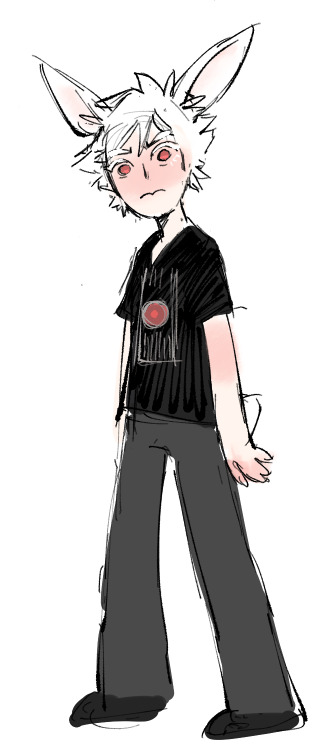
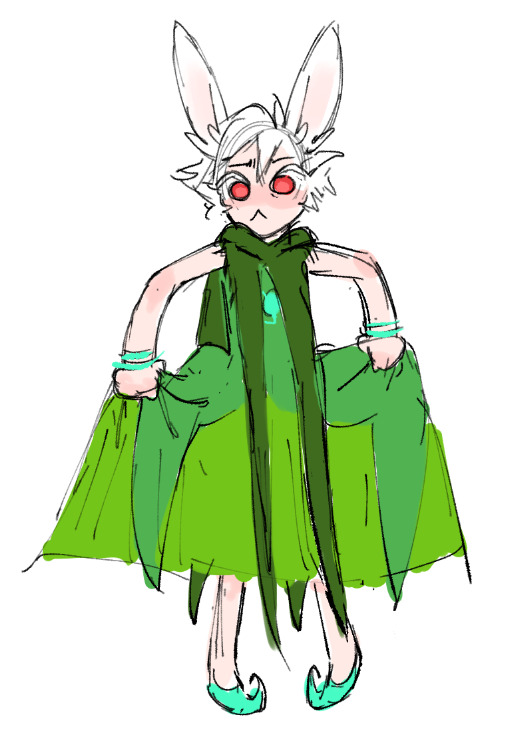
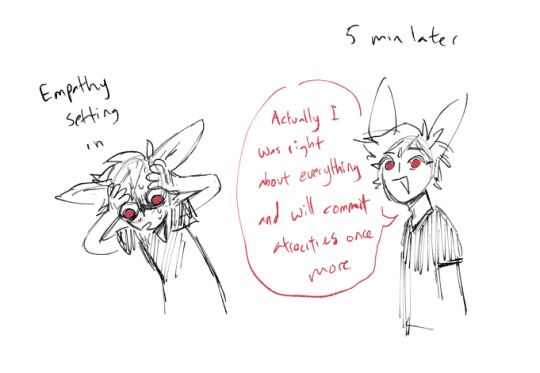
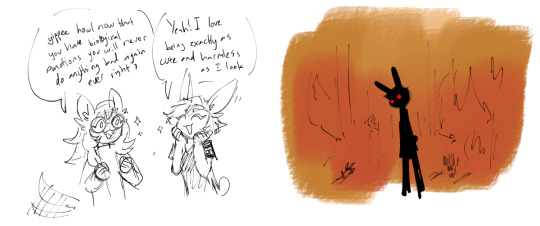
#homestuck#lil hal#hal strider#lil' hal#been writing a lot of hal lately i love his 'moderate sociopathy' actually#obsessed with him tbh#he's SUCH A FREAK#anyway he's a bunny boy bc hes the white rabbit in the alpha kids' alice in wonderland theming#jane = alice | dirk = queen of hearts | jake = mad hatter | roxy = cheshire cat#and he's a sylph of mind bc tbh all his emotional problems are mind-esque#and hes a FUCKIN ENABLER
117 notes
·
View notes
Text
me when a piece of media/character is Alice in Wonderland themed:

#this is about:#twisted wonderland#wonderlands x showtime#ever after high#alice in borderland#also bonus: me when a character is cheshire-cat themed#rui kamishiro#kitty cheshire#che’nya#chenya#chishiya shuntaro#alice in wonderland#project sekai#pjsk#twst#heartslabyul#riddle rosehearts#maddie hatter#lizzie hearts#tsukasa tenma#emu otori#nene kusanagi#arisu ryohei#usagi yuzuha#kuina hikari#ann rizuna#trey clover#cater diamond#alistair wonderland#bunny blanc
575 notes
·
View notes
Text










#나비#softkiseu#navi s#dami#dreamcatcher#dc dami#dami icon#dami aesthetic#dami layout#dami moodboard#dc moodboard#film moodboard#vintage moodboard#indie moodboard#fantasy moodboard#lofi moodboard#dreamy moodboard#dark moodboard#deep moodboard#edgy moodboard#kpop moodboard#gg moodboard#black moodboard#voilet moodboard#alice in wonderland#themed moodboard#vibe moodboard#magical moodboard#art moodboard#illusion moodboard
116 notes
·
View notes
Text
i simply think that it is beautiful that kon both wears his heart on his sleeve and also keeps his innermost secrets deep inside & would rather make himself sick over them than put the burden on someone else 🔥he can agonize over superman not telling him he has a secret identity, or tim not revealing his real name, and be relatively upfront and candid on how he feels but do nottt make him think about his suicidal tendencies or he’ll—well.
#i’m kinda haunted by that post i made a while ago about kon’s emphasis on truth in relationships#& why he struggles with secret identities in general (clark + tim + adjusting to smallville despite that being what he wanted)#bc Surface level he is very much open about how he feels#but below that…. well that’s what alice in wonderland themed nightmare sequences are for#like he’s not gonna admit that he’s being protective over bc tana died#but. we know.#kinda jumbled thoughts but i’m trying to get better at explaining what’s in my brain 🦭#kon el#what’s bro yappin about#dc
37 notes
·
View notes
Text
Hey everyone!! 🎃
It's Halloween already, so I'll be drawing the last few costumes today QwQ
Your ideas were all so brilliant!! I'm sorry, I genuinely wish I could draw each one, but unfortunately I am just a little creature with two smol hands and a single tablet pen.

Nevertheless, thank you all sooo much for bombarding me with messages and showing so much appreciation for my silly little drawings (˚ ˃̣̣̥⌓˂̣̣̥ )づ♡ It means the world to me and interacting with y'all brought me so much joy!!
My askbox is always open and I'm always happy to interact - just might draw a little more slowly/do some coloured pictures for a change, haha. (I also may or may not go back to some of your ideas at a later date. Like for real, you guys are good)
To all inmates: hope you enjoy the Meropide celebrations! Happy Halloween!!! (㇏(•̀ᢍ•́)ノ)

#Halloween#Wriothesley#Sigewinne#Neuvillette#Alice in Wonderland#Mad Hatter's Tea Party#Genshin Impact#sketches#my art#Alice in Wonderland theme courtesy of my frend#now it's your turn to Trick-or-Treat the Duke!
90 notes
·
View notes
Text


…this was really just my excuse to draw masquerade sticks
#thsc#thsc fanart#the henry stickmin collection#henry stickmin#ellie rose#charles calvin#henry stickmin fanart#thsc ellie rose#thsc charles calvin#thsc henry stickmin#I literally realized a few hours after I finished that the masks kinda look like they have an Alice in wonderland theme#that was NOT intentional but I like it :D#I really do need to design more masquerade masks I love this
102 notes
·
View notes
Text

going insane over this path design ive been working on and need to share instantly
#yes my island theme Is going to be wonderland#yes im extremely normal about alice in wonderland#why do you ask#acnh#animal crossing new horizons#acnh community#acnh inspo
71 notes
·
View notes
Text

LOOKING GLASS
#my art#postal#postal dude#postal 1#tw body horror#tw eyestrain#tw blood#(rips open my shirt to reveal another shirt underneath that says I LOVE ALICE IN WONDERLAND THEMED MEDIA)#tried proper overpainting rendering and ngl i like it a lot
58 notes
·
View notes
Text

Bringing this ship to the table and dramatically running away. Melzelle everyone
#I'm so terrified posting this#Nonoplease let me explain#(has zero reason other than they're cute and also melanies only ever conversation invokved her going for a TEA PARTY which is adorable)#(and also it made me think mel would be alice and wonderland themed)#Anyways is this anything#Melzelle#regretevator melzelle#regretevator melzelle fanart#regretevator#rokea's display case#regretevator fanart#regretevator roblox#regretevator melanie fanart#regretevator melanie#regretevator mozelle#regretevator mozelle fanart
79 notes
·
View notes
Text
Marcille’s dress: threads and importance

This was supposed to be part of my upcoming Marcille & Chilchuck arc analysis, since it’s all about the themes of fantasy and confrontation with reality in Marcille’s arc, her mental state and fairytale coding etc etc, but that already was long af and this is something good to have as a standalone anyways, so. Here we go.
……….. So first of all it is 12 of august and suddenly my work phones are ringing to break me the news:

So this interview came in right when I was working on this analysis again. This now confirms the main intent of what the outfit was meant to evoke. There’s definitely a looot to look into just this and we’ll be going into it, but a complete analysis of Marcille & Momcille analysis would be ideal & that’ll be for another day. We will be bringing her up often throughout all this though.
So. "Why should I care about Marcille’s outfit?" Beyond possible story importance, on a metatextual and thematic level, analyzing imagery something provokes can be valuable and compelling even if it isn’t intentional or is flawed (historically inaccurate, etc). Less narrative wise and more character development wise, the lion does say the dress was to give her courage, and as her demon his job is reading her heart and giving her what she desires. What does her outfit say about her overarching character and her current mental state? Why does it give her courage, how does it do that, what part of it does that?
Like I just implied, when talking about this sort of thing, there are two aspects: the personal meaning something holds for the character, and imagery for the audience, which may or may not align with said character’s perspective or intent. Character vs meta. Because of the meta aspect, imagery can be disconnected from the character or the wider narrative, or that disconnect can itself be a tool to show the character’s mental state, unable to recognize or reconcile how different to their intent their being comes across as. This is to say that all of the analysis angles I’ll be bringing up in this post can apply to the same analysis of Marcille’s character and psychology, even all simultaneously. The different sections here are more or less ordered from most meta angle first to most character-motivated and strictly analyses of canon last, with little interludes examining specific aspects of the outfit regardless of reading. Imagery here will be looked at as a framing device, a way to comment on the themes and her character or her arc. For fun! Forward march!!
Table of contents:
Shepherdess: guidance.
Sorceress: power.
Princess: fantasy.
Funeral gown: mourning.
Mother: emotion, balance and identity. The conclusion ⭐️ Skip to here for strictly analysis of canon intent
Shepherdess
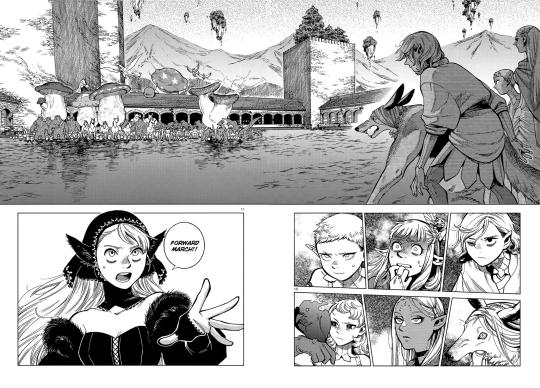
We’re doing an iceberg but I start from the bottom and make my way up, the shepherdess reading is the most meta one but it’s also the one I’m most interested in covering. It’s the longest section and the one with the biggest (only), um, history lesson. Feel free to skim if you only want the conclusions and not the reasonings.
Marcille? A shepherd? In action and wider imagery, the links are more or less straightforward (and will be discussed), but first I want to tackle the visual aspect because it was the most striking part of it to me and it’s the most complex one to explain…
The shepherdess look has been honed into a specific image in modern consciousness. There are always the same essential elements: a curved hook staff, a hat (often a kind that curls around the head), a poofy skirt for an elegant dress (wether fancy or modest), most often with lacing down the front and some cleavage. It’s of course not anywhere close to a perfect match if you compare Marcille’s dungeon lord outfit to pictures of shepherdesses, but it is very reminiscent. Nowadays, the classic hat of shepherdesses that Toy Story’s Bo Peep is emblematic of is indeed considered mostly a child’s accessory as well, halfway between a trimmed hat and a cap, has the shapes of a bonnet, so this coincidentally also lines up with the elven earmuffs as I’ll touch on later.
What
Wether or not seeing Marcille’s dunlord outfit will have reminded you of a shepherd probably depends decently on culture? I did research to get material for this and the start was real rough let me tell you— the only things I could find were… Bo Peep from Toy Story and illustrated nursery rhymes. In modern times, the image of a shepherdess, "shepherd woman that looks ladylike", is only a vague understanding we’ve gathered from the few woman shepherds we’ve seen in media that weren’t meant to be historically accurate. Myself, without Toy Story it’d only have felt like hazy fever dream memories of illustrated nursery rhymes from my childhood. It’s impressive that this concept still persists even if it’s only perpetuated through ONE character and a niche archetype, and for the word shepherdess to have had such a strong association with this look in my mind still.
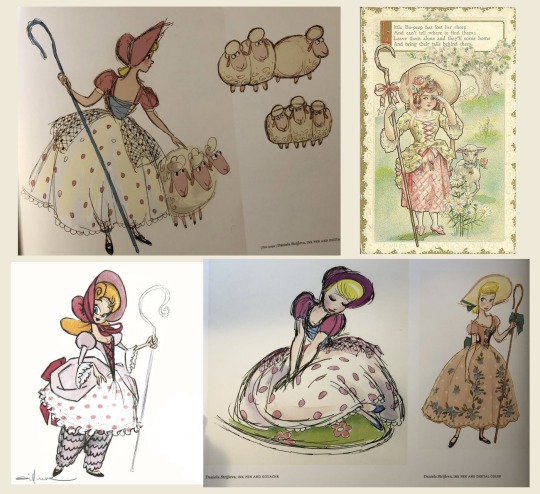
Above: concept art for Bo Peep from Toy Story by Daniela Strijleva and Jean Gillmore, herself based on the nursery rhyme Little Bo Peep whose depictions are always in this style of outfit. Top right is a depiction of Little Bo Peep in a 1913 postcard, unknown artist, but if you want you can look up for vintage picture book depictions as well.
So what the hell? Where does this very specific look for the concept of a woman shepherd come from? Where does this conception, this specific shepherdess style wear and figure originate? Well the specific term that’ll get your research results is indeed "shepherdess". Art history time let’s go.
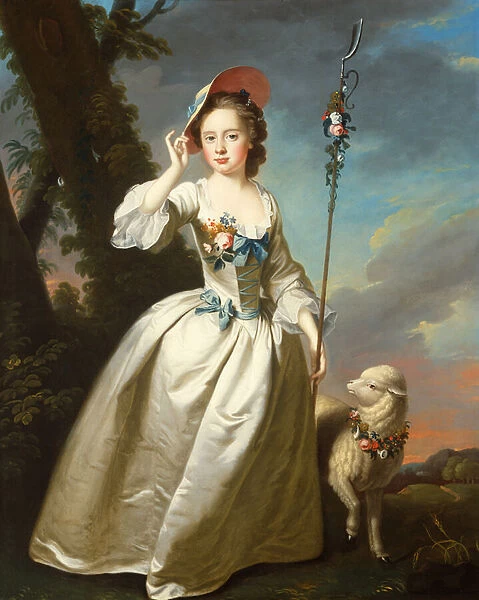
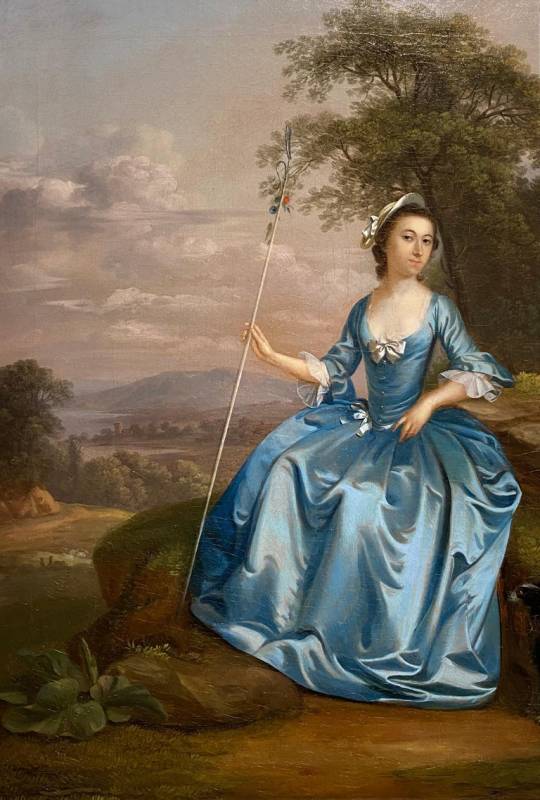
Okay so there’s no way those people were actually shepherds, right? What’s with that? To cut to the chase, turns out it’s mostly a trend that popped up in 18th century, one most associated with rococo but also with romanticism. Yes yes, a trend. The bourgeoisie deciding from hearing about the painted selfies of other ladies that dressing as fancy versions of poor people is hip. The new hit, becoming a dainty ladylike shepherdess for a day!




Artwork credits: In order, 1: Thomas Hudson (1701–1779) / 2: Arthur Devis (1712-1787) / 3: Jean-Honoré Fragonard (1750-1752) / 4: Sir Samuel Luke Fildes (1844-1927) / 5: Léon Sault (1839-1921) / 6: T. H. Lacy (1865) Some fun extra sources: Anecdotes: "Marie-Antoinette playing shepherdess", statues by John Cheere, Essays: Extravagance in revolutionary times: ladies of rococo, cottagecore through history, haven’t read this one but focuses on the shepherdess figure in 18th century plays and scultpures
Googling "ladies dressed as shepherdess" will give you a slew of 18th century portraits of, indeed, well-off noble ladies having portraits of themselves painted while dressed as "shepherdesses", well, the romanticized version of one anyways. I also found one from the 1650s. The trend also continued onwards, albeit less so once culture moved on. The word definition itself acknowledges this, unlike its french equivalent, as far as I know women shepherds are often still just called shepherds, meanwhile the shepherdess as per the Oxford dictionary: a female shepherd, or, an idealized or romanticized rustic maiden in pastoral literature. I don’t think I can do the explanation of the phenomenon’s origin and cultural context better than the essays I linked so I’ll quote:
"During the 18th century, an artistic movement known as Romanticism spread throughout Europe, seeking to evoke an idealized world of rural simplicity in contrast to the urban, industrialized centers of the cities. This nostalgic vision of a peaceful countryside was expressed through various art forms, including oil paintings and lead garden statues. The subjects of these artworks often depicted shepherds, huntsmen, and other rural figures, presenting an idyllic way of life, particularly for urban audiences." -Vizcaya Museum
"The cottage core aesthetic that people think and strive to attain, follows the ability of the wealthy class to be able to get away and take a break from the aristocracy and city life by escaping to the country. Marie Antoinette was an example of this, “… she had an entire hameau (rustic village) built as a place of leisure: it comprised meadows, lakes, grottos, streams, a dovecote, a dairy, cottages, vineyards, fields, orchards, vegetable gardens, and pagan temples. It was a fully-operational farm, where the queen would host social events. She and her entourage would “cosplay” as farmers and shepherdesses.” Marie Antoinette shows the “pretty,” the fantasy that people want, people want an escape from their reality. Cottage core is very different from one’s life, and the lack of knowledge of the true struggles of simple living, farming, and other cottage core elements makes people imagine and create a fantasy." -ZOESTAM1 (you’re a legend ty)
"Renowned for her great interest in fashion and more notably her extreme extravagance, Marie Antoinette set this ideal of the common shepherdess or milkmaid through her enjoyment of dressing in costume. She would often don the clothing of a dairymaid, a pastime that went so far as to see her commission the building of her own personal dairy at her palace Le Petit Trianon. These Rococo versions of lower class dress feature heavily in rococo painting such as in Fragonard’s The Shepherdess (1750-52), where a middle class woman is seen wearing a highly exaggerated interpretation of the dress of a lower-class woman. However, despite complying with the details of shepherdess dress it still features the expensive fabrics that are seen in images of Madame Pompadour. This interest in the pleasures of pastoral life shows the extent of the ‘myth and fairytale, festivity and fantasy, theatre and music’ that was epitomised in the paintings of the elegant women of the Rococo. The dresses made for and worn by the ladies of the Rococo are emblematic of the changes in society. The newly found ease of life for the middle class is seen in these images through the mythical landscapes, statues that appear to come to life and through the elaborate dress of the figures that combines a sense of the élite with that of the costume of common man. Wolfgang Menzel describes the Rococo in 1859 as a time that represented ‘empty and meaningless ornamentation’, a feeling that was certainly shared by the lower classes of Paris and one that was expressed in the French Revolution in 1789. The revolution sought to punish those of a higher class, meaning that figures expressed in the paintings of Fragonard, Boucher and Watteau would be guillotined within the same century." -Gabriella Sotiriou
To be sure, there have also been depictions of shepherdesses in history that were realistic and accurate, humble, commonfolk, both before and after this movement. There’s just this… Sweep in the 18th century that forever changed the aesthetic associated with the shepherdess figure in a part of culture.
So to summarize. Rich ladies LARPing as rural peasants for fun and portraits. From there you can easily see the throughline of how this very elite vision of a shepherdess would become the model for if, say, a children’s book illustrator wanted to design a shepherdess for a nusery rhyme, books which at the time would be luxury goods, the target audience noble little girls who should aspire to look as cute, elegant and well dressed as the shepherd girl in the book. Okay! We just have to get lost in the sauce a little more before getting to a full look and conclusion.
More fun context, in english the main shepherdess nursery rhyme is Little Bo Peep, don’t ask me how it goes I have no clue. But in french I could mention many like the nursery rhyme Il était une bergère (there once was a shepherdess) that comes from the 17th century, but the most sung one and the one I knew growing up is Il pleut, il pleut, bergère (it’s raining, it’s raining, shepherdess) originally from 1780. I did not expect this when starting to fall down this whole rabbithole going "Haha dunlord Marcille kinda looks like Bo Peep", but looking at that latter song’s wikipedia page there’s a whole thing there too. It was sung right after the storming of the Bastille during the very beginning of the french revolution in 1789— In which the opening lyrics, warning the shepherdess that rain is starting and a storm is coming, to "get your sheep, go home, and take cover"(though more poetically), became more goading than the original fairy godmother energy. The shepherdess here in this revolution context became the queen Marie-Antoinette, and the rainy storm is the french revolution brewing. It is said that that the author of the song hummed it at the gallows before being executed at french authority’s decree. We see then just how much the figure of the rococo shepherdess became a symbol with hated connotations and ties to rebellions.
So! The figure of the shepherdess is hazy to most people nowadays, but historically it was associated with excess, extravagance, classism, misused unearned power and the then-queen of France. It was both the ignorant and selfishly idealistic aesthetic that the queen wished to embody and that twisted the original commoner humble conception of a shepherdess, and the infamous image embodying her faults that was then used against her in mocking resentment and revolutionist sentiment. The representation of the fantasy world she created for herself with her power, and the ironic reminder of the real world she was exploiting and ignoring to do so.
You’ll notice the shepherdesses are typically blondes, especially in Bo Peep or more modern depictions. Marcille’s name is french.
What
… But all of that was just to inform on the topic before we got to the links and parallels that can be drawn between it and the story & Marcille, and to prove I’m not making up "the shepherdess look" in the first place. I already briefly went into visual similarities and appearance-related connotations (bonnet, rounded staff, dress with cleavage, lacing like a corset, poofy skirt, elegant and formal yet promiscuous undertones) in the previous section, so now I’ll be properly going into what this comparison can mean for her and for the narrative.
I summarized this section as shepherdess: guidance, and ultimately that’s what I think this focuses on best about her.
I do a quick overlook of her mom friend tendencies here (+ here) if needed, but I think we can agree Marcille often acts motherly through canon, not only fussing over her friends and coworkers often overbearingly so but also directly caring for them like helping them bathe, enjoying being able to do that for people she cares about (washing Senshi’s beard included). But also, often deciding herself to adopt a sort of wisdom-imparting dynamic within a group or relationship where she knows what’s best for others better than the individuals concerned do, where she’ll scold or push others out of their comfort zones as if she’s doing them a favor (Chilchuck), where she’ll talk in a holier-than-thou tone about a topic (often an academic or moral one), that classic long lived race condescension as some characters put it.
So isn’t the figure of a shepherdess, one who cares after sheeps, one who directs them in a direction she chooses and watches over them grazing the grass as their protector guardian and guide fitting? Isn’t that what she figuratively wants to do, obtaining unfathomable power to shape others’ lives quite literally even to the point of changing their lifespans regardless of their thoughts on the matter, being a figure that chooses for them and keeps them safe as someone who knows better? A bundle of good intentions and genuine care, but still patronizing and robbing them of their freedom of choice. I’d argue this is a large part of her arc with Chilchuck, and even for her dynamic with Izutsumi! Looking at Marcille saying farewell to Izutsumi near the end when she thinks she’s going to prison, it’s easy to wonder about how this is the same Marcille who once refused to trust Falin’s judgement and choice to be with her brother, thought she shouldn’t be away from her and what Marcille decides to allow and not allow for Falin’s career— the same Marcille who here in tears with Izutsumi is telling her to take care of herself as she leaves to travel alone, trusting her to make choices for herself by herself and supporting her in it even through her heavy emotions and the grief and loss she’s already anticipating, but learning to accept.On a more literal parallel level, in this last arc she commands an army of monsters at her will effortlessly, making them march towards the surface and then into battle. Sending out orders through her hands, words and staff like a war general, ready to choose to change the world to fit her wishes.
As to what feelings dressing like a shepherdess could quell, I think it’s a way for her to reaffirm her goals and feel certain in them. Her friends she respects just told her that her lifelong goal of extending everyone’s lifespans is a pipe dream that could do harm as much as good, and even though she ignored her it did shake her, it is after that and just before the upcoming battle that the winged lion deems she’s in need of a morale boosting wardrobe change. Marcille feels more directionless and aimless than she should, so the winged lion gives her an outfit that reaffirms and steels her goals, examplifies her motherly and controlling instincts and validates them, encourages them. Wouldn’t a shepherdess figure make sense then?
The fakeness aspect of the shepherdess fashion also reflects how she’s not fit to be a proper dungeon lord, as that requires maintaining an ecosystem that she doesn’t have the knowledge, experience or will to manage. She’s a shepherdess in looks and has the power to command people places, but she doesn’t have the hands-on farming experience that is needed to make a dungeon lord a competent one, a good gardener so to speak. Marcille has high academia knowledge of dungeons but when it comes to basic care that’s more in line with farmer experience, she’s largely stumped. She lets herself be moved by aesthetics rather than practicality, like with her spiders and her coatl.
If we put the history of the shepherdess figure in context with her arc, she wants to mimic the look of a folk hero, while still being privileged with power she can exerce over others. It gets to a key trait and arc theme of Marcille: romancitization. Which is in big part tied to her idealism, and that idealism often makes her more resistant to accepting things, but now I’m getting ahead of myself.
(Ironically, as we’ll go over in latter sections) This can also reflect how Marcille’s mother was an elf, presumably from high elven society from her elegance, court etiquette and magical skills- (meaning she likely got a good education), but moved to a tallman region feeling its culture less stifling and more fun, prefering its food and clothes etc etc. She’s still court mage, but to elven society being part of a short lived race’s court is a downgrade from being part of elven society at all, so here the "noble willingly becoming "lower class" because they find it pleasant or fun" is fitting. (Not an actual critique of her choices or morals whatsoever, just an observation.)
Marcille is not seemingly in touch with her elven culture. The dress tallman fashion, but the earmuffs would be elven, perhaps denoting the wrong or fully romanticized usage of it. Like meshing two things together that clash— in-world in this case cultures, but here in context it’d be class, and as we’ll touch on later in another section, identities.
Marcille also grew up around in a rural region surrounded by "books and chickens", so it’s not like a rural identity or a relationship with farm animals is fully irrelevant or separate from her as a person. The chickens make the egg imagery Marcille uses to explain souls in the same body and in some art extra interesting.
Like mentioned, shepherdesses also obviously have an association to lambs and goats especially. Which is fun not only for figurative parallels like her leading the monsters and everyone like lambs to slaughter into war but also how the demon has been shown as a goat and a sheep before. In a way though, Marcille is the lamb innocent as she is and the demon is the shepherd. After all, Marcille’s dress even has some animal-like features, fur all over including her ears and even a tail. The dress is not only to make Marcille feel more confident, but to distract Marcille from having second thoughts and self-doubt that could make her think better of being a dungeon lord, like she ends up doing after talking with her party in the tower. The demon takes on forms to lure in his victims, as the adventurer’s bible puts it forms that make his victims trust him. At his very beginning, he would take on the form of food and offer himself up for eating. Similarly, I think it’s interesting to consider the dynamic between Marcille and Winged Lion as one where he presents himself as a servant, as the one guided and ordered and not the one pulling strings and walking her like a sheep to breaking him out of the dungeon. You could also mention how the sheep form the demon has taken before is when he was traumatized in a way— The time all humans died around him that made him live in loneliness for what’s implied to be quite some time, the time when he reconsiderd his whole approach from people pleasing towards cunning and control.
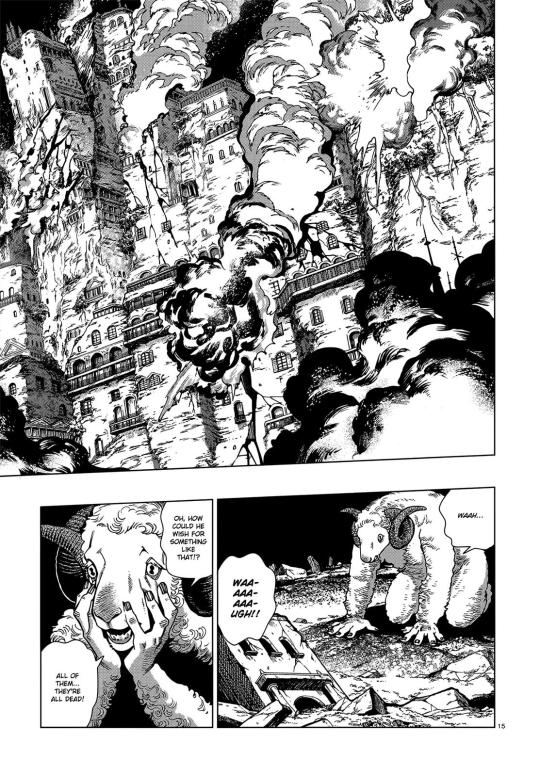

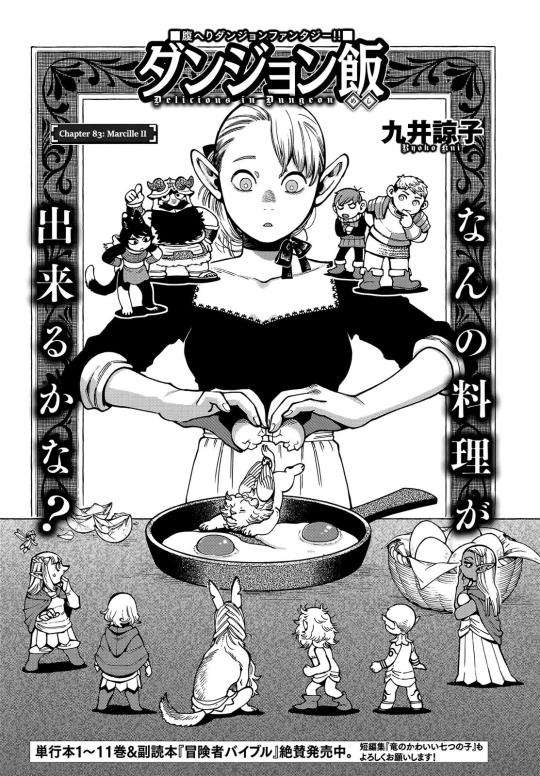
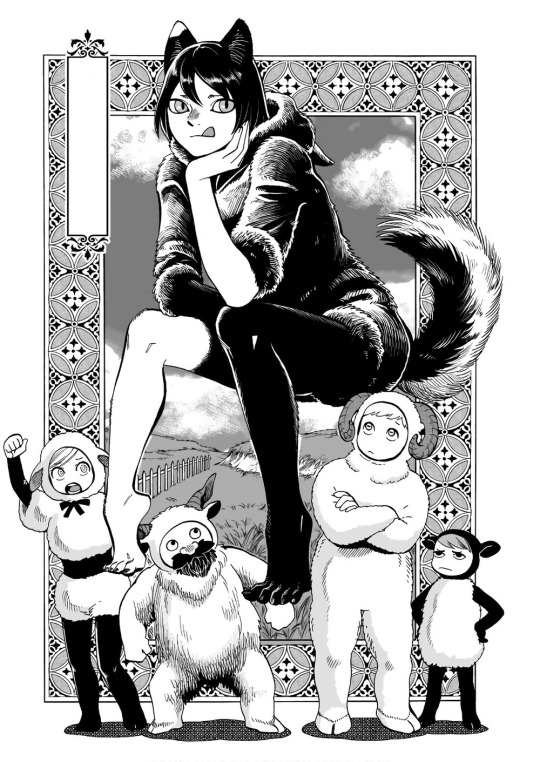
Tldr: - History makes it a good comparison for aesthetic-obsessed well-off people who want to play folk hero while actually being selfish or misguided, it’s a paradox of a humble station represented by unattainably expensive fancy flourish and frills. - Marcille herself is of rural origins where she interacted most with books and chickens. She has a taste for over-the-top aesthetics and dresses (not as much as the golden kingdom’s people, but enough to desire her dunlord dress) and novels, and she is a mom friend type, caring after others (in bathing and dressing and healing and comforting and guiding) - As a dungeon lord, the way she commands an army of monsters in perfect synchrony with shepherdess-like staff in hand makes the shepherdess comparison very literal. The demon having been notably a goat, a sheep and maybe even a lamb in the past also makes this imagery more compelling and fitting.
This angle shows Marcille wanting to take on the role of the shepherd, the lighthouse so to speak, the mother that guides the people whom she wants to change the life & world of for the better. They need only follow her lead and they’ll be shown how great their life could be.
Where does this imagery fall? Definitely all meta and not in-world, this is for the audience and has no in-world acknowledgement whatsoever. Again. I know this was kinda insane, this is the most wild and meta section of the post like I mentioned and like I implied I don’t even personally think it was intentional on Kui’s part honestly! But as art doesn’t exist in a vacuum, even when there’s no intent, imagery can bring an interesting and relevant framing, angle or flavor to the original text. A lot lines up well and there are small coincidences, but again I am not saying Kui intended Marcille to parallel Marie-Antoinette help. Isn’t it kinda neat though… Just a little bit…
Okayy so things are calming down from here on out we’re cruising guys
Interlude: earmuffs, elven but childish
It was important for me to get a groundwork analysis done for the earmuffs before going into the next ones. This interlude has a focus on supporting the shepherdess section with comparisons, but I want to take a moment to focus entirely on elven earmuffs, their connotations and existence as an in-world fashion accessory, and thus environmental context for how Marcille may see them.
So, if we go back on the shepherdess for a bit— The shepherdess fashion had a hat iconic enough for it to be called the bergere hat, but the type that’s more associated with them nowadays is the type that Toy Story Bo Peep wears, which is a bonnet.
To me it’s intuitive to say that elven earmuffs are very alike bonnets, even in cultural context. I recommend browsing the wikipedia link I put for the pictures. It used to be very widespread and popular headwear, and to be fair probably still is even though not fashionable much anymore. It used to be, though, fancy pretty laces and this and that were put on it and trends were made of it. A type of bonnet especially has become emblematic of the shepherdess look, like mentioned.
The elven earmuffs are subject of discourse within the fandom and the biggest reason is the age connotation they have, and I do have to say it’s less strict in practice than people like to say. Kui not only keeps herself from explaining the social perception of them in a categorical end-all be-all way, but we also see a range of earmuff designs worn by adults in the doodles. We see that adults can and do wear them even if we don’t have much coherent context for it, and perhaps more importantly we see it implied that there is a market for earmuff designs especially with the fashion of it, which solidifies there are customers and adult customers for them.
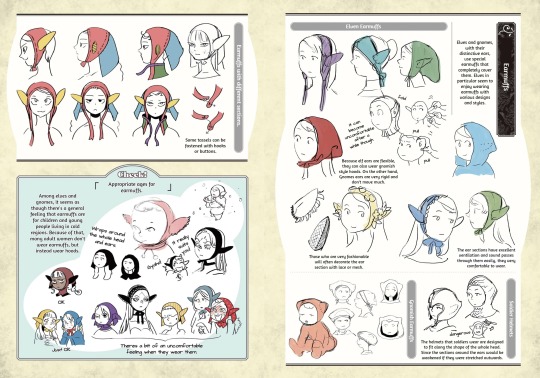
Similarly to bonnets irl, it might feel weird to see an adult or anyone wearing it, but it’s not like it’s illegal or strictly reserved to some kinds of people. Rather, it’d be embarrassing, like the elven bonnets in Dungeon Meshi. It covers ears while still looking and feeling dainty, often accessorized and designed with lace or ribbons. It’s very strongly coded with babies and was very popular across baby dolls, ads, etc, though it’s starting mostly considered vintage nowadays. Though these are associations so strong that for example in Alice in Wonderland, the original book like the 1999 movie, when the baby gets transformed into a pig, understanding that the pig is the baby and A baby remains smoothly because it keeps its bonnet. It helps sell it.

(And if we’re referencing Alice in Wonderland while talking about Dunmeshi, psst, look up the chapter cover for chapter 64, rabbits 1)
Beyond babies the traditional simple bonnet is associated with rural people especially women. I do not want to sound like a bonnet expert because I am not— but from my understanding it does make sense if in occident rural people are the majority of who still wears them to this day. One reason being that more isolated less rich regions tend to care about being trendy less, and expectations on dress differ from region to region of course— And that’s a point I want to make about elven earmuffs, because I do think especially in colder regions like Kui mentions they would be more widely used and considered commonplace for older adults like perhaps the ones in the doodles. Just like how gnome hats go in and out of fashion constantly, Kui does have a good grasp of how fashion can be treated and coded amongst people and groups. It’s earmuffs for a culture Marcille isn’t fully in touch with, so it could take part in reaffirming Marcille’s identity and belonging in it, wether or not she knows all of what it implies. Like said, in the pages we see seemingly earmuffs high fashion for adults. It’s something young teens and young adults are said to be culturally ok to do, and people do generally like to look young so, it could be part of the cute hip young woman look. Would it be thematic for her to wear childish outfit? Yes, but I honestly can’t see it bringing her "courage" much if that’s the main intent. We’ll talk about it more later though.
Some do say that historical fashion is Kui’s weakness so to speak lol, and I’m not one to disprove that. Again, I can’t claim to know what Kui intended or didn’t intend to do and where she got inspiration from consciously or not.
Sorceress
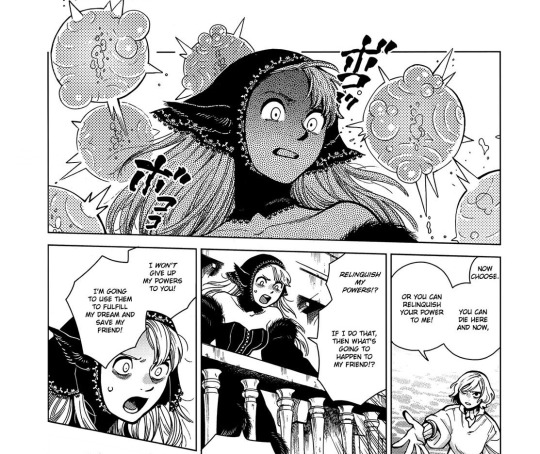
Okay okay okay my enthusiasm for explaining historical/trope meta sorta started and ended with the shepherdess let’s get this done. I am interested in laying the groundowrk that I’m not making shit up in pop culture and for that I have to build up context so we’re all on the same page, but this is just what it says on the thin. If you want a recap of tropes surrounding black magic sorceresses and how they look beyond the minimum, here’s a couple relevant tvtropes pages: Evil Wears Black, Evil Costume Switch, Evil Sorceress, skimpy villains. More interestingly, you could argue that Dungeon Lord Marcille apparents herself most to the vain sorceress, even though what she would like to be is closer to the lady of black magic akin to her mother’s demeanor, and meanwhile the regular Marcille we know and love acts most like the black magician girl. The latest I would have never guessed existed is a trope of a spunky outgoing girl deuteragonist who’s gifted in dark magic and it’s honestly really fitting, which I find a really on the nose coincidence. This is still optional, beside the points I’m about to make.
Marcille, like Chilchuck, is concerned with reputation and social perception. Beyond other examples of it, there’s how Marcille prefers to let other people believe she’s a full elf and how Thistle’s shaming affects/embarrasses her — her reason for not being upfront about her origins socially not being shame but that it’s a hassle to explain and deal with, the questions and judgement and differential treatment, but moreso!!! There’s how similarly, she’s not ashamed of her dark magic research & knowledge, but she avoids talking about it. She knows it’s a touchy topic and kept the main topic of her research a secret for 2 years of working together. It only came to light because it was absolutely necessary to save Falin. She knows the reputation of dark magic and readily fires off counterarguments to Chilchuck talking shit about it with quick practiced ease.
But now as she becomes a dungeon lord and the canaries know everything and they’re are after her, there’s no more hiding or pretending or deflecting. She embraces the reputation of dark magic and her academic identity fully with an outfit that screams "I’m a black witch" and wears it like armor.
This is more in line with what the people who don’t know Marcille were framing her as during her dungeon lord stint, Marcille’s in-world image at that time, the same way Thistle became known as the mad mage with time. Evil sorceress. Dark witch. It’s the epic villainess look. Mixing Maleficient with a D&D seductress look. It does a lot of skin especially for Marcille, off the shoulder sleeves, a line of skin showing from inbetween her breasts to her navel, a skirt cut like Rin’s dress... The deadly sin of lust in french is the word for luxury— lust is desire but it’s for as money or power as much as sexuality.
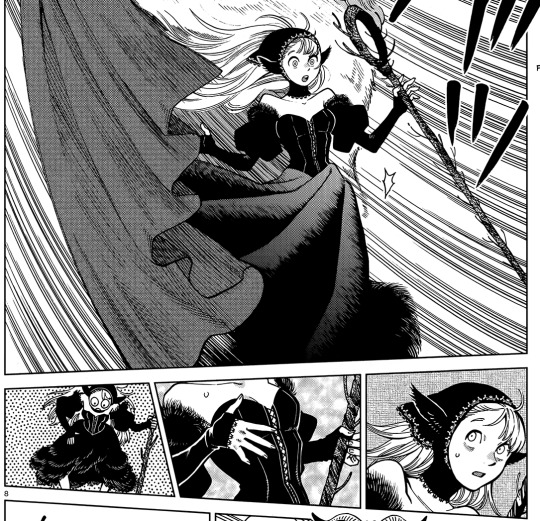
Unlike with the shepherdess there’s less specific boxes to check. The main’s color black or at least dark, there’s magic (preferably black or forbidden or cursed) and the outfit’s feminine and elegant and a dress? You got the winning recipe. Then there’s extra boxes like having a fur or feather trim, having a magic staff, long sleeves… If you want examples beyond literal Maleficient, I’d google for sexy sorceress halloween costumes lol. Google also showed me some AI art that’s exactly what I’m talking about whole looking those up and that sorta drives the point that this has become a vague but striking figure. We’re not operating with poofy skirts here, that’s for the kooky villains. But the length of the skirt and the vibe is right, and fur and especially feathers aren’t unheard of tacked onto their dresses, which ironically Maleficient both wore in her important 2014 movie, funnily enough the year Dungeon Meshi’s serialization started. Though, especially with her barefootness it also gives her a of… Lost fey witch vibes more than dark sorceress, depending on how you see it.
Oozing maturity makes you feel in control. It makes you feel adult and powerful and independence. This is also very true for the mother section later on, but here we focus on the confidence aspect and less the assurance, if the distinction makes sense— Confidence coming from within yourself and assurance coming from an external source in this case.
"Fumi you’re saying Marcille wanted to look like an evil sorceress?" No! But unconsciously or not she’s drawing on these vibes. She’s done hiding and she’s done hiding the topic of her research and what she’s ready to do to succeed, the extent of her determination, her "dark" magic, that very term she’s been fighting against. She’ll wear a dress that reflects that and gives her confidence in pursuing what she wants in plain sight. It’s relevant for this to remember that Marcille getting her dunlord makeover is soon after she had a conversation with her friends who tried to talk her out of her biggest trauma and purpose and want, even laughed at her goal, and juuust before a huge life or death battle. She laid it all out bare and told the full story and the full truth and argued a bit, and now she’s sent them away for a time while she does her dunlord thing and bam here’s your confidence dress my queen. You’re scared about the canaries? You just need a fit to remind you you’re strong and kick ass. You know, because you’re a cool mage with convictions and nothing holding you back anymore and also you’re hot and in control.
She has power now, the demon even referring to himself as it, Power, and she’s going to wield it. Feels confident in seizing and using it— momentarily.


Is this angle character or audience focused? I do think both, because yes these powerful vibes would make her feel confident like I went over and theorized, but definitely a lot relies on an audience level. It’s our official sign, to both us readers and to Laios’ party explaning their reactions lmao, that "oh she’s truly lost it". This is her dark evil wardrobe change. We see her get her goth makeover and we know she’s gone to the dark side. Jojo Siwa moment. (Sorry)
Interlude: fur, luxurious but monstrous
Ok what’s up with all the fur on her skirt and sleeves and the furry ears though. Why a poofy fur dress. We’ve never seen Marcille show interest in fur lined outfits or such before. At most, there’s her trying out the golden kingdom outfit, with its antlers and leopard pelt uhh lointcloths? Which- that is a point to make I suppose lol, gave her a taste of bold high fashion. Her dress is pretty out there as the character reactions hint. Here’s even someone from reddit comparing it to Cardi B’s 2024 met gala dress! If you go back to the earmuffs pages, there’s one ear design with something that looks like fur too. More seriously, fur has long been a way to show class and wealth, because they’re expensive, especially on garments that are meant to be not just practical but pretty.
Quoting @room-surprise : "Costume design wise, the gown just screams class and wealth and power, like as a costumer when I saw it I immediately went 'evil renaissance queen on her way to war'."
But, especially the furry ears, for a manga about monsters that feels quite on the nose right? As revealed by the official dunlord Marcille acrylic stand pictured later in the post, she even has a tail. It definitely represents that her opinion on monsters has shifted imo. Like, it could be just visuals but then that defeats the psychological look into Marcille that the outfit gives us, it could just be a nod to who’s really in control or aesthetics, but I do feel it shows how Marcille has grown less repulsed of monsters. Let’s remember what Marcille said about eating monsters in the barometz chapter, that even if it isn’t logical she has a fear that eating a monster means taking something bad into herself, that it’s dirty and corrupting. Marcille, who takes horror in knowing that fertilizer aka poop has been used to grow vegetables that she then ate. She’s always had a bit of disconnect with ecosystems and the cycle of life so to speak, foiled by Senshi, she wants to defeat death and she doesn’t know how to balance a dungeon because she has trouble tending to ecosystems unlike Falin, she sees them like math when she should see it all as organic living balance. So in the end, it can either show that her mental state is so unstable for her to have been reduced to such a state alongside her barefootness, or on its opposite that she’s accepted the important place of animals and monsters more in the world, that she doesn’t see them as dirty anymore, or even that she likens herself to them. Maybe she’s become a bit of a monster herself, after all, because the dungeon does corrupt, the dungeon devours like how its structure was once compared to a digestive system by Laios, because if the demon isn’t a shepherd and Marcille isn’t a sheep the demon is still who actually has control over everything in the dungeon including the monsters, despite wanting to make believe it’s the dungeon lords who do, because the dungeon lord is a puppet of a demon, just another one of its monsters, its creatures in its guts.
Princess : fantasy

This is it this is the moment. I reworked my post structure after the interview but this was originally going to be the last angle explored after funeral gown instead of before it, this is also the angle that’s most important to my Marcille & Chilchuck analysis. Dungeon Meshi has some fairytale and princess prince royalty knights etc etc imagery and this is a continuation of that in a way, topic for another day though.
As we know Marcille is someone who loves aesthetics, she loves novels and pretty things and idealizing and romanticizing, and this can be seen as the core of the outfit to her. If her situation feels unsettling, it can be fixed by a change in framing, by an aesthetic by an angle by a cool look. Something that inspires and makes the situation feel less alarming, positioning herself as the protagonist rather than the villain. It was given to her by the Winged Lion when she started being more anxious to the battle that is to come, it has the goal to make her more confident but in this context very pointedly the goal to make that self-doubt go away— to keep Marcille from thinking about her situation some more and realizing she may be on the wrong path, it’s to isolate her in her dungeon lord world as part of her role, it’s to keep her in that malleable unstable state and encourage her to chase fantasy and stay in her own bubble of makebelieve. Do you follow me? It’s "don’t think about the stakes, don’t rethink your goals, what you’re doing is right and you should keep going however you want to", it’s "you don’t have to face reality, I’m here and now your dreams are the reality that matters". It’s fantasy.
It’s an epic poofy dress that makes her look cute yet cool. It’s the imagery of a princess in a tower. Calling out to her from beneath a balcony, overseeing her army and her kingdom. A princess dress not unlike the one she felt embarrassed in in the Golden Kingdom, where they talked of prophecies and kings, and wanted to be complimented in, to laughter and dismissal. And even though those things feel more disconcerting in real life than it does in stories then, becoming dungeon lord is good at blurring the lines to the point you can’t tell your doppelgangers of loved ones aren’t the real thing, and the Winged Lion chose her so that has to count for something, she was chosen.
If the princess imagery is left unnoticed by Marcille herself, then I definitely think it was meant for the audience to some degree. If not the poofy dress and heroine status alone, then the tower imagery and the balcony scene. The tower and the princess, the dragon, the knight, the prophecized king, the witch, the monster army, it’s all very reminiscent of fairytales like I mentioned. The balcony thing is a classic play thing though like that is Romeo & Juliette imagery right there, calling out to her from beneath a balcony?!! Aladdin too, Rapunzel, heroes and princes climbing towers to come see and save princesses.
This is the point that is most related to her love of novels and dalclan. Romanticization may be the name of the game for the history behind the shepherdess outfit style, but then fantasy would be the princess’. It’s also about twisting your current situation into something positive despite everything, but Marcille wasn’t that far gone yet, just struggling, framing and aesthetic still subtly help sell it all though. But if there’s something that’d make Marcille feel more confident and ready to do something, hype herself up or give her a twinge of comfort outfit wise, it’d be one that makes her feel like a princess.
Interlude: black, solemn but gloomy
Short one because it’s very straightforward but black is traditionally associated with evil and death, etc etc. Because of the former it’s often associated to powerful malevolent figures like villain sorceresses, but because of the latter irl it’s widely the color of funerals. It’s also cultivated this connotation of elegance, this sleek clean look both in modern and noble contexts, it’s very much this image of cool and ushakeable composure. Interestingly, we can’t 100% tell because mangas are in black and white, but black seems to be Marcille’s mom’s color, what she always dresses in.
Funeral gown

This was the most popular reading by the fandom before the interview and with good reason. As we got the confirmation, it’s nudging towards the intended one! It argued that the dress is a funeral gown, because her mother wore dresses like it and because of its black color, meanwhile the childish earmuffs are because her mourning her father happened when she was a child, because she feels frail etc etc. In her state with her current worries she’s feeling thrown back into her childhood, not unlike Thistle’s weird ambiguity there, feeling helpless just like then except now she has power to change it and a devil on her shoulder telling her all she has to do is affirm herself and take it.
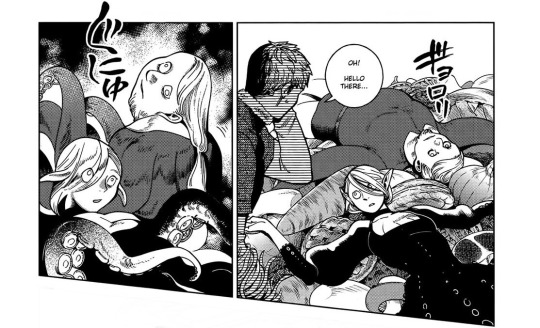
It’s externalizing her trauma and validating it in turn, offering some catharsis and reminding her of her goal, defeating death so she never has to endure loss again.
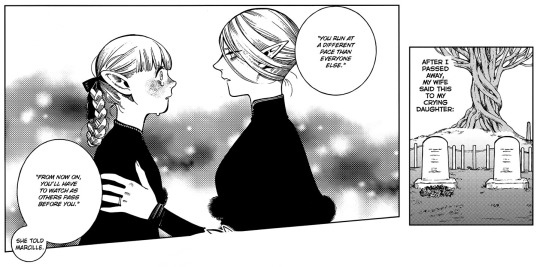
As you may notice, both their outfits here are fur-lined too, so the amplification of that in her dunlord dress may be similar overcompensation to how she made the dress very revealing.
Interlude: barefootedness, filthy but earnest

Bloodstained bare feet no less. From what I can tell this is a direct callback to her being barefoot when resurrecting Falin. Again this could be a way of reminding herself of her goal and reminding herself all she’s accomplished, but it’s notable that Falin’s resurrection is something that made her feel very guilty and indecure because of how her becoming a chimera turned out. Maybe more about reminding her of what she has to fix and that she can’t give up on her goals including Falin.

Beyond that it’s interesting too though! Prim and proper Marcille who cares about her appearance and pouts at dirt just walking everywhere barefoot like nothing can hurt or bother her. There’s a sense of her being messy as a dungeon lord, her hair isn’t in an updo and looks unbrushed, she’s in a weird uncharacteristic outfit in a questionable mental state and she’s barefoot on top of it all. It also recalls a sense of vulnerability of course, reminding again an unstable mental state or showing desperation or how naked she might feel. Inversely, it can be more about acceptance, like in the last interlude we talked about knowing your place in the ecosystem and feeling secure in accepting it. Walking barefoot is to bare your skin to the ground, to walk knowing they’ll get dirtied and not minding it. Did you know humus and humilty are from the same word root?
In the end, it gives both ethereal forest fairy vibes and also poor little orphan vibes. Victorian sick child, especially when she gets carried by the winged lion all overwhelmed too haha. Very much gives her out of touch vibes, even if the bloodstained look is powerful. She’s willing to get her feet hands dirty to do what must be done.
Mother : balance
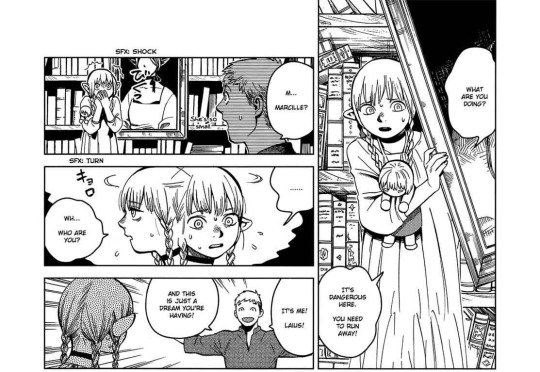
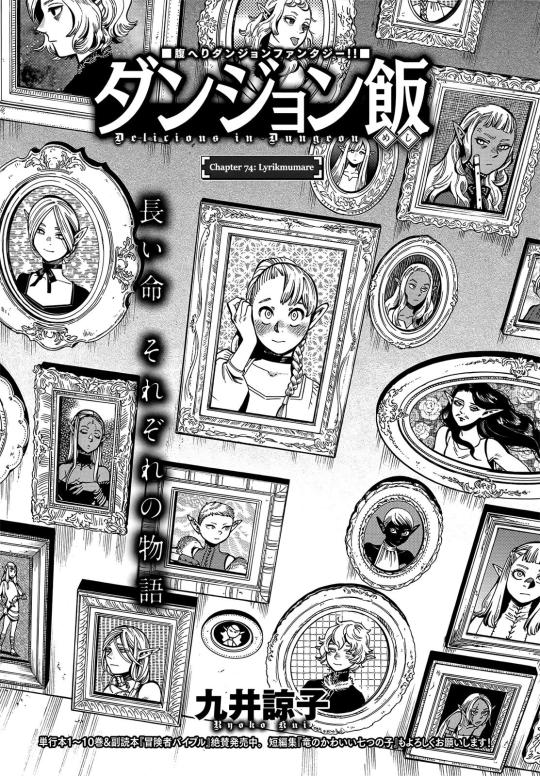
I turned this section into an excerpt post as well, here’s a link, serves as an essier to share highlight + allows me to put in more pictures since we hit the limit here…
Kui: "I just combined [a dress like what] her mother liked and [earmuffs] which are considered a little bit childish."
See what it’s doing here? Kui combined a dress from her mother with a hat for children, adult dress vs childish hat. Adulthood vs childhood. Mother vs child. It’s also notable that the dress is tallman fashion while the earmuffs are elven. Again she’s combining those distinct things into one. It’s about emotions and maturity. Stability and instability. Growing & potential vs having grown & knowing yourself. It’s about her cultures and expectations and how can she possibly keep up with all of them, like the genius child she was portrayed as? It’s duality it’s conflict it’s being pulled in opposite directions. It’s about identity.
Marcille wants to have all the answers and wants them all already, she already acts like she has everything figured out more often than not, when it comes to ways to harvest mandrakes or her image of Falin and Chilchuck and orcs or her rigid sense of ethics, but the story does show that she had growing to do, plus her main goal beyond keeping her friends safe and near her is that pursuit of knowledge for what she doesn’t yet have answers for— rewriting the laws of life and death. But, as we’ve all been told before, death is simply a part of life and we have to make our peace with that one way or another. Like Marcille says in the last chapter, this was in large part the lesson and arc she’s had to go through. A lesson that Marcille’s mother has learned herself, one that she has accepted and tried to pass on to her daughter, which didn’t work and kickstarted Marcille’s pursuit of extending lifespans. Marcille has to settle with uncertainty, with knowing life can end at any moment and knowing this is who she is even if the world has no answers for her as to what that means, she has to come to terms with ambiguity and inbetweens.
Marcille’s relationship with her mother is very interesting because it’s shown all in very small moments and implications, but we do see that Marcille’s mom is arguably her biggest role model. She’s the one who shows up in Marcille’s nightmare about monster food early on, she’s who told Marcille she’ll have to bear loss througout her life due to her lifespan, Marcille wears a choker like she does, it’s debatable that Marcille mimics her demeanor to seem more elven and dignified, in Marcille’s true nightmare she hides behind a portrait of her, she was the only living elven role model Marcille had around. Mother, who didn’t let grief of her husband rule the rest of her life, having even remarried, mother, who’s a court mage, mother, who pursued a life she wanted even if it cost her a lot. And we do know being an elf is important to Marcille! She seeks to conform to elven beauty standards rigidly, both in gender presentation and things like facial hair, and she’s masked as one since she was enrolled in the magic academy, as far as we know her first time away from home and her first big period of social contact since she isolated herself with chickens and books when she was younger. Books like the daltian clan, with an all elven cast except for the one half-elf she deeply related to.
Marcille’s bangs are also half down and half cut. Before she had to cut some hair to make familiars, long bangs were what Marcille wore for years, meanwhile in all of Marcille’s childhood flashbacks including at the magic academy her bangs were always cut short. As we know, hair is important to elves. Her hair is elfness. Her hair is elegance. Her hair is her age. Her bangs are uneven now. It’s part of accepting her precarious weird spot in an inbetween, half up half down haircut. Acceptance on her own aging, that there’s no empiric answer for what Marcille’s equivalent age is in elf or tallman or other, maybe just a ballpark if even that. Answers which are what she’s most desperate to know. What do you mean that student over there has got an astronomic result on her dungeoneum and what do you mean she doesn’t really care for how you did it? Falin who’s thus showing her another way to be, with less self-made pressure, that you can just go with the flow- that you can just… Be.
Her hair being all down and messy as a dungeon lord is part of making the characters and audience understand that Marcille is out of it, but… Like her barefootness there’s some flexibility it implies, for Marcille who’s so rigid on appearance. Accepting her hair to be messy, a sort of shedding of who she is even as she’s overdressed and trying so hard to look like something she doesn’t feel as.
That’s why her outfit makes her feel courageous. Because it makes her feel different from who she is otherwise, because it grants her a look she feels naked without, even with barefeet and messy hair. It’s externalizing how she’s been trying to hold it all together and all her confliction and her feelings and offering some catharsis, no more hiding herself, she’s a half-elf trying to do dark magic. Clean Marcille, clean clean Marcille— Overthinking the dressing, the superficial the aesthetic, without looking enough at the body it’s covering up, the laws of the world the ecosystem of the dungeon the opinions of her friends’— what’s standing right in front of her face, the underlying thing holding up the rest of what she’s trying to change, what’s truly important. She’s back to being like with meeting Falin, overfocusing on the details and the nitpicks and the theorics while oblivious to the slimes and the bats and the balance of mana in that small cave dungeon. She has the dress and the hat but as a whole she doesn’t look like a slay queen or a princess or a cool sorceress or even like her mother, she just looks like a mess.

Ultimately after calming down she takes the hat off. She leaves behind the grip that her childhood trauma had on her and moves forward in the dress of adulthood, with maturity and emotional intelligence and logic to deal with her current situation instead of coping mechanisms and desperate grasps for control. And then when the dungeon lord becomes Laios her dress poofs, she’s in her very plain pajamas, plain Marcille, and it’s that Marcille who goes forward to help Laios save the world and defeat the demon. Hence why post-canon she starts dressing in similar dresses to her mother as well, and starts wearing more black. Black here is a color associated with her mother. She keeps her own touch and color here and there, like her red choker instead of a black one, but it’s a stark and sudden difference. She’s matured.
And her friends aren’t afraid to say it like it is and bring back her feet to the ground instead of up in the clouds of fantasy and power where she was, her feet back on the dirt of where they are right now instead of the theorics of "when" and "then" and "forever". She’s weird, she’s unique, in some ways she doesn’t fit in with any group anywhere, and that’s ok and she’s accepted that it doesn’t mean she can’t feel belonging and joy as herself with her flawed friends in a flawed world. After all they did stick with her even after seeing her whole tantrum and embarrassing breakdown makeover. Personally I do say, slay queen.
Her dungeon lord outfit is a coming of age outfit in a very literal way. A bridge between childhood and adulthood. We see her struggle metaphorically between the past and the future, moving on or holding onto trauma. The dress, from her mother, with cleavage and low cut sleeves and a lace gap going down to her stomach and a very short risqué skirt cut, represents maturity but it was very purposefully contrasted with the earmuffs, a childish piece of accessory associated with youth. This shows her mental state, battling with her emotions, wildly fluctuating between her academic put-together powerful self and the childish emotional outbursts the pressure is causing. Time moves on too fast but she’s not growing up fast enough to keep up or make the academic breakthroughs she wants— time is always running out and she’s both too young or too old she’s pulled in both directions and she can never be up to standards. It represents her struggle with her lifespan, her struggle to fit in, to know who she should be and what she should be doing. Considering this, it’s no wonder Marcille is someone who finds ecosystems and the cycle of life unappealing and unintuitive notions, because she has to carve her own space wherever she goes.
Conclusion

Her friends are laughing because she’s doing one of those over-the-top sexy costumes with a baby bonnet and both of those are extremes uncharacteristic of her and the whiplash of Marcille out of anyone in that weirds them out. They’d take plain old marcille in her pajamas over all-powerful dungeon lord Marcille in an epic revealing goth dress any day. Marcille with messy hair is crossing the line though someone braid it please.
Marcille had a flair for the dramatic, values the grand and the novel-like, big gestures and being swept away by knights. As was discussed in this post of mine and as will be covered in my Marcille & Chil arc analysis, fantasy is something she uses to make the world more digestible, less scary, more handleable. As such, I can totally see how a gown that makes her feel larger than she is, more important or, more narratively, like a protagonist, like a sorceress and a princess, and understood and validated in her mourning, would make her feel like she can tackle things more, better in her own skin, or perhaps, giving into the delusions ever so more. She needs a dose of reality and dw her party (chilchuck) will come to give out that.
Dunmeshi prones the importance of balance for both a healthy body and a healthy mind and hope & fantasy vs logic & reality aka optimist idealism and cynical pessimism are one side of that.
"Fumi, do you really think Kui intended all of this?" To a good degree I wouldn’t be surprised, but ultimately that’s not what matters bc this is still compelling cultural context and themes to read into the text, like I mentioned at the start. Diversity of interpretations is good!! It’s a sign of a deeply rich story! I think in 15 years we’ll still have essays being written on Dungeon Meshi and I think that’s incredible and no small feat.
#I had this post in my wips since december and 2 days after I make the brunt of the shepherdess research Kui’s interview comes out?#My life is a joke#Dungeon meshi#Marcille donato#dunmeshi costuming#Spoilers#Dungeon meshi manga spoilers#Has Fumi reached her maximum level of insanity yet? This may be setting a new bar#Fumi rambles#Marcille lost fey w lamb pelt dress ouuuuuuh#I feel like people use meta to say anything nowadays but THIS is metatextuality this is intratextuality transtextuality etc#Things that make me feel like i’m back in college#Analysis#meta#Marcille’s mother#Alice in wonderland themed analysis of Marcille when. Marcille needing to conform to society and adult expectations#Even in her unusual developmental and multicultural situation when#Alexa play Dead Mom#I need a break sorry if there are typos or unlinked links. Idk what coherence feels like anymore. 9.5k words enjoy#I can just edit in if i remember anything. Right. Right#Sorceress: It feels good to step out of the good girl zone to no longer have to be bound by that!!!#Funeral gown in reverse of the sorceress— it’s about vulnerability and showing it off to the world#venting out all the feelings she’d kept inside and hidden for a long time!!! Things ballooning until its bursting!!!
41 notes
·
View notes